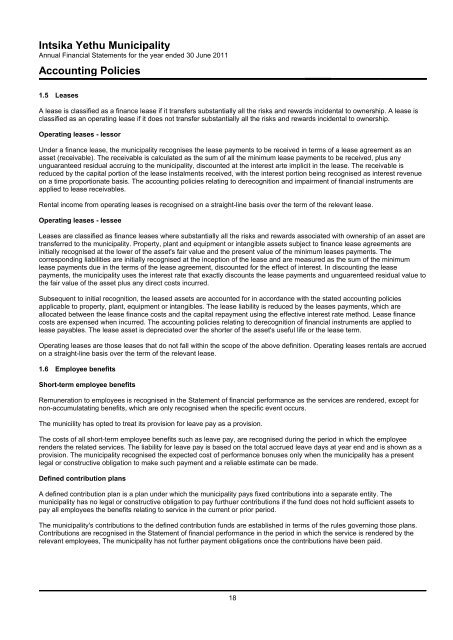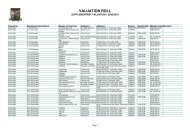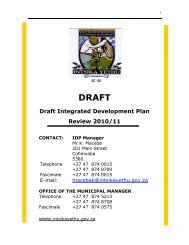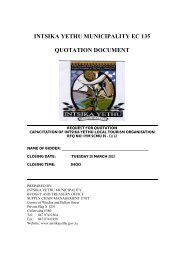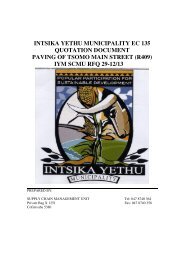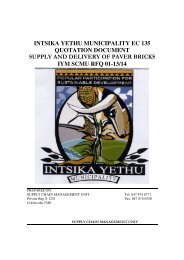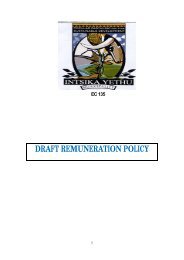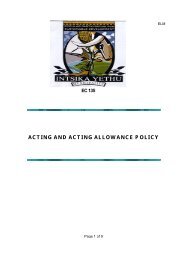annual report 2010 - 2011 - Intsika Yethu Municipality
annual report 2010 - 2011 - Intsika Yethu Municipality
annual report 2010 - 2011 - Intsika Yethu Municipality
Create successful ePaper yourself
Turn your PDF publications into a flip-book with our unique Google optimized e-Paper software.
<strong>Intsika</strong> <strong>Yethu</strong> <strong>Municipality</strong><br />
Annual Financial Statements for the year ended 30 June <strong>2011</strong><br />
Accounting Policies<br />
1.5 Leases<br />
A lease is classified as a finance lease if it transfers substantially all the risks and rewards incidental to ownership. A lease is<br />
classified as an operating lease if it does not transfer substantially all the risks and rewards incidental to ownership.<br />
Operating leases - lessor<br />
Under a finance lease, the municipality recognises the lease payments to be received in terms of a lease agreement as an<br />
asset (receivable). The receivable is calculated as the sum of all the minimum lease payments to be received, plus any<br />
unguaranteed residual accruing to the municipality, discounted at the interest arte implicit in the lease. The receivable is<br />
reduced by the capital portion of the lease instalments received, with the interest portion being recognised as interest revenue<br />
on a time proportionate basis. The accounting policies relating to derecognition and impairment of financial instruments are<br />
applied to lease receivables.<br />
Rental income from operating leases is recognised on a straight-line basis over the term of the relevant lease.<br />
Operating leases - lessee<br />
Leases are classified as finance leases where substantially all the risks and rewards associated with ownership of an asset are<br />
transferred to the municipality. Property, plant and equipment or intangible assets subject to finance lease agreements are<br />
initially recognised at the lower of the asset's fair value and the present value of the minimum leases payments. The<br />
corresponding liabilities are initially recognised at the inception of the lease and are measured as the sum of the minimum<br />
lease payments due in the terms of the lease agreement, discounted for the effect of interest. In discounting the lease<br />
payments, the municipality uses the interest rate that exactly discounts the lease payments and unguarenteed residual value to<br />
the fair value of the asset plus any direct costs incurred.<br />
Subsequent to initial recognition, the leased assets are accounted for in accordance with the stated accounting policies<br />
applicable to property, plant, equipment or intangibles. The lease liability is reduced by the leases payments, which are<br />
allocated between the lease finance costs and the capital repayment using the effective interest rate method. Lease finance<br />
costs are expensed when incurred. The accounting policies relating to derecognition of financial instruments are applied to<br />
lease payables. The lease asset is depreciated over the shorter of the asset's useful life or the lease term.<br />
Operating leases are those leases that do not fall within the scope of the above definition. Operating leases rentals are accrued<br />
on a straight-line basis over the term of the relevant lease.<br />
1.6 Employee benefits<br />
Short-term employee benefits<br />
Remuneration to employees is recognised in the Statement of financial performance as the services are rendered, except for<br />
non-accumulatating benefits, which are only recognised when the specific event occurs.<br />
The municility has opted to treat its provision for leave pay as a provision.<br />
The costs of all short-term employee benefits such as leave pay, are recognised during the period in which the employee<br />
renders the related services. The liability for leave pay is based on the total accrued leave days at year end and is shown as a<br />
provision. The municipality recognised the expected cost of performance bonuses only when the municipality has a present<br />
legal or constructive obligation to make such payment and a reliable estimate can be made.<br />
Defined contribution plans<br />
A defined contribution plan is a plan under which the municipality pays fixed contributions into a separate entity. The<br />
municipality has no legal or constructive obligation to pay furthuer contributions if the fund does not hold sufficient assets to<br />
pay all employees the benefits relating to service in the current or prior period.<br />
The municipality's contributions to the defined contribution funds are established in terms of the rules governing those plans.<br />
Contributions are recognised in the Statement of financial performance in the period in which the service is rendered by the<br />
relevant employees, The municipality has not further payment obligations once the contributions have been paid.<br />
18


